Book contents
- Frontmatter
- Contents
- List of Illustrations
- Traditions in World Cinema
- Introduction: Transnational Film Remakes
- PART I GENRES AND TRADITIONS
- 1 Disrupting the Remake: The Girl with the Dragon Tattoo
- 2 Fritz Lang Remakes Jean Renoir for Hollywood: Film Noir in Three National Voices
- 3 The Cultural Politics of Remaking Spanish Horror Films in the Twenty-first Century: Quarantine and Come Out and Play
- 4 ‘For the Dead Travel Fast’: The Transnational Afterlives of Dracula
- PART II GENDER AND PERFORMANCE
- PART III AUTEURS AND CRITICS
- Notes on the Contributors
- Index
3 - The Cultural Politics of Remaking Spanish Horror Films in the Twenty-first Century: Quarantine and Come Out and Play
from PART I - GENRES AND TRADITIONS
Published online by Cambridge University Press: 22 December 2017
- Frontmatter
- Contents
- List of Illustrations
- Traditions in World Cinema
- Introduction: Transnational Film Remakes
- PART I GENRES AND TRADITIONS
- 1 Disrupting the Remake: The Girl with the Dragon Tattoo
- 2 Fritz Lang Remakes Jean Renoir for Hollywood: Film Noir in Three National Voices
- 3 The Cultural Politics of Remaking Spanish Horror Films in the Twenty-first Century: Quarantine and Come Out and Play
- 4 ‘For the Dead Travel Fast’: The Transnational Afterlives of Dracula
- PART II GENDER AND PERFORMANCE
- PART III AUTEURS AND CRITICS
- Notes on the Contributors
- Index
Summary
The financial potential of horror films has long been appreciated by producers and others in control of film finance. Many of the most successful horror films of recent decades, from The Texas Chainsaw Massacre (Tobe Hooper, 1974) to Paranormal Activity (Oren Peli, 2007), have been made on low budgets and have subsequently found large audiences that in turn ensured they provided high returns for those who had invested in them. Many of these successful horror films have also been part of cycles of production that have thrived on the reproduction of particularly familiar themes, settings, narrative structures and even visual styles and motifs. This reproduction of features that audiences are already accustomed to and familiar with highlights the horror genre's historical and continued reliance on the duplication of elements that filmmakers see as central to their appeal and which in turn contribute to their popular and financial success.
The slew of productions that appeared in the 1970s that centred on possession and exorcism are typical of such recycling and reworking of popular ingredients. In this case the cycle was driven by the popularity and global box-office success of The Exorcist (William Friedkin, 1973) and examples of productions influenced by it included a wide variety of international interpretations of that film's basic formula. These ranged from Turkey (Seytan, Metin Erksan, 1974) to Spain (Exorcismo, Juan Bosch, 1975) and Italy (L'anticristo, Alberto de Martino, 1974), with each instance offering similar stories of demonic possession in a number of different cultural contexts. In these cases the films were marketed in a fashion that clearly evoked Friedkin's hugely popular film in the hope of attracting local audiences who hoped that these more local titles would offer generic similar pleasures.
One way in which contemporary producers have attempted something similar is through remaking horror films that have already proved that their stories have box-office potential. Once again, the basics – plot, character, narrative organisation and even visual style – have demonstrated that they can be successful, so their reworking should prove less risky for financiers than a new product that may be more difficult to market and sell. As Ryan Lizardi has noted, the recent history of the horror film has seen a reappearance of various stories and figures from the 1970s and 1980s.
- Type
- Chapter
- Information
- Transnational Film Remakes , pp. 54 - 65Publisher: Edinburgh University PressPrint publication year: 2017



